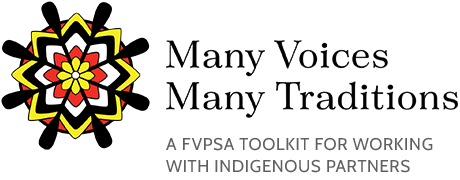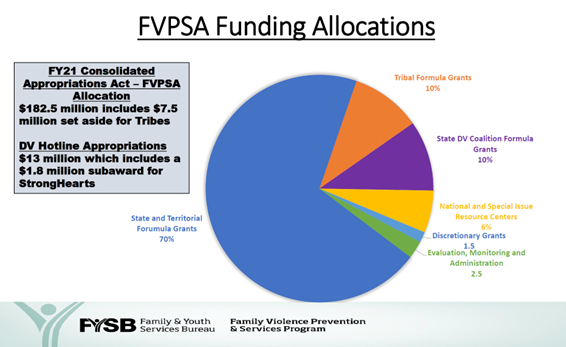A note about language
Readers will note that the term “Tribes” is used throughout this section specifically rather than Indigenous Nations. The language shift in this section is due to the terminology and definitions used by the FVPSA statute and regulations as it relates to eligibility to receive FVPSA funding directly from the Federal government.
History
The battered women’s movement of the 1970’s garnered public attention through tireless advocacy, including gaining the attention of state and federal lawmakers. The 1978-1979 testimony from Tillie Black Bear (Sicangu Lakota), Del Martin, and others fueled action at the Congressional level that eventually led to the passing of the Family Violence Prevention and Services Act. (See: National Indigenous Women’s Resource Center (NIWRC) FVPSA Fact Sheet)
FVPSA was first enacted in 1984 and began as demonstration grants to States and federally recognized Tribes and Alaska Native Villages. It is the only source of Federal funding solely dedicated to funding domestic violence shelters and supportive services for survivors, their children, and their dependents. FVPSA has been reauthorized twice and amended seven times over the years with the most recent reauthorization occurring in 2010 (42 U.S.C. § 10401 et seq. see: Codification).
Purpose
The FVPSA Statute at 42 U.S.C. § 10401 outlines the four intended purpose areas of the funds:
- Assisting States and Tribes with their work to increase primary and secondary prevention of, and public awareness about, domestic violence
- Assisting States and Tribes with their work to provide immediate shelter and supportive services to survivors, their children, and their dependents
- Supporting and maintaining a National Hotline where survivors and the community can reach out to access services nationwide and/or learn about domestic violence
- Supporting training and technical assistance about domestic violence and provision of services for States, Tribes, partner agencies, and the community
Funding Allocation
As described in the History section, FVPSA funding began through demonstration grants. In 1992, the grants changed from demonstration grants to mandatory formula grants and FVPSA first delineated a specific percentage of the funding formula that was to go to Tribes.
Currently, the FVPSA Statute at 42 U.S.C. § 10403 specifies how the funding appropriated by Congress is to be spent. 90% of FVPSA funding is distributed via mandatory formula grants to States/Territories, Tribes, and State/Territorial Domestic Violence Coalitions. Out of that 90%, 70% is distributed to States/Territories to pass through to eligible subrecipients for prevention, shelter, and supportive services. 10% is distributed to Tribes to fund prevention, shelter, and supportive services, and the remaining 10% is distributed to State/Territorial Domestic Violence Coalitions for training and technical assistance.
Of the remaining 10% of FVPSA funds, a minimum of 6% must be distributed to training and technical assistance organizations, and the Federal Government via the FVPSA Office may only keep 2.5% for administration, monitoring, and evaluation. The remaining 1.5% is utilized for discretionary grant funding.
Through discretionary grants, FVPSA funds support 15 national technical assistance (TA) providers including the National Indigenous Women’s Resource Center (NIWRC), Alaskan Native Women’s Resource Center (AKNWRC) and the National Network to End Domestic Violence (NNEDV). Collectively the national technical assistance providers are known as the Domestic Violence Resource Network (DVRN). Members of the DVRN are funded to provide training and TA on capacity building, best practices, policies, and resources to FVPSA grantees.
The National Domestic Violence Hotline (the Hotline) receives a separate appropriation (i.e. line item) in the Congressional budget which is why they are not listed in the above formula. In 2017 a partnership between the Hotline and NIWRC created StrongHearts Native Helpline, a Native led hotline for Native American survivors.
As described in the Family Violence Prevention and Services Program Funding for Tribes and Tribal Organizations Overview webinar on June 30, 2021, Congress set aside additional FVPSA funding for Tribes through the annual budget process in Fiscal Years (FY) 2018 through 2021. In FY’s 2018 and 2019, Congress set aside an additional $5 million, $7 million in FY 2020, and $7.5 million in FY 2021. The additional $24 million dollars over the last four years has helped raise the average minimum amount that Tribes have received through FVPSA’s mandatory formula grant process. The Coronavirus Aid Relief and Economic Security Act (CARES Act) and American Rescue Plan Act of 2021 (ARP) has added additional funding to help Tribes and tribal organizations respond to the ongoing COVID-19 pandemic.
While supplemental funding is welcome and has provided Tribes with much needed resources, it is important to remember that supplemental funding is temporary and not guaranteed. As with any grant funding, the appropriated amounts are determined by Congress each year and funding can ebb and flow over time. An increase in one stream of funding may be accompanied by decreases in other critical funding streams at State, Federal, and local levels. Additionally, some funding streams may remain steady despite rises in inflation and other economic downturns as described in State FVPSA Funds and Tribes: The Need when FVPSA funding for Tribes remained at only $24,000 for several years. Such uncertainty in funding underscores the importance of States needing to fund Tribes with their State FVPSA pass through dollars.

